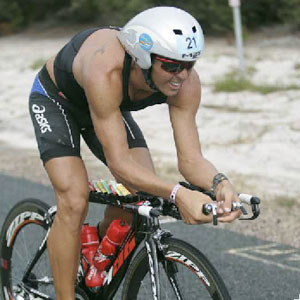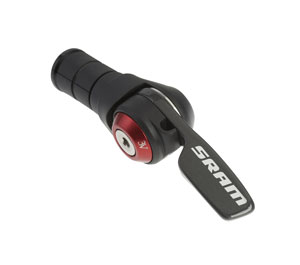A Look into LOOK for 2009
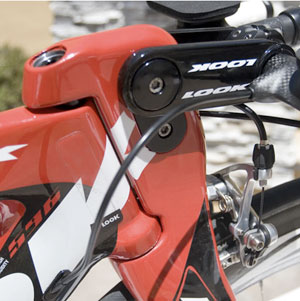
LOOK’s growing presence in the triathlon realm is evidenced as Slowtwitch.com was taken through its 2009 Tri line. And while they have truly competitive new products, their design principles take a different tack – one that perhaps changes conventional thinking of what aero really is.
Exiting the Pacific after an open water swim at Moonlight Beach a couple weeks ago, I spied Aussie Luke Bell standing on the shore, waiting for his wife to finish up with her own splash. Since I had just returned from a trip to Los Gatos, Calif. to have a look a the coming 2009 LOOK bicycles range, it was the first question out of my mouth of Bell, a LOOK-sponsored pro:
“Dude, do you have it yet?”
With a sullen look like a boy who didn’t get his Red Ryder for Christmas, he replied, eyes downcast “no… not yet.”
“It,” of course, is LOOK’s new 596 triathlon bike. Bell will soon be getting “it” seeing as how he’s one of the brand’s key sponsored pros. But for now, the only ones that do are two guys: Patrick Vernay, who won the Roth Challenge on it this summer in the bike’s maiden voyage, and some French age grouper named Laurent Jalabert. Must have some kinda connection or something.
So another new tri bike. Yawn. Companies are popping out bikes with deep tube sets, narrow profiles, tricky brake placement and tight tolerances ad nauseam. LOOK is adopting some, but for much, it’s got a different view.
As such, they’re taking a different tack in designing the new 596 Tri than what the market is doing. Call it crazy. Or call it clever. Because who says the rear wheel’s most optimized position is tucked the width of dollar bill into a seat tube cowling? Indeed, that is the viewpoint LOOK has on why their first triathlon bike, the 496, and now their new 596 have a gap between the rear wheel and seat post. LOOK invited us to Los Gatos to explain. We’ll get into it, but first a primer on this historic French brand.
LOOK… at us then.
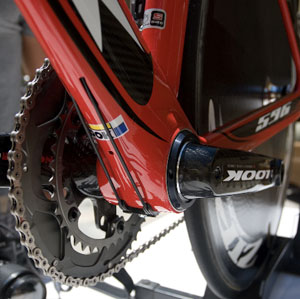
LOOK has typically been at the tippy-top of the bike brand hierarchy; it dates to 1983, when LOOK created the first clipless pedal. Two years later, The Badger, Bernard Hinault, won the Tour de France on them. The pedal remains a brand focus with the popular Keo line.
They grew the brand’s popularity further with a line of lugged carbon frames. In 1992 and ’94, Frenchman Laurent Jalabert, then with the Spanish Once squad, grew his legend by claiming a pair of green sprinters jerseys at the Tour de France, aboard a KG96. In recent years, LOOK moved to full monocoque carbon, and hasn’t looked back.
Of course, it has always remained a rather exclusionary brand. If you saw someone on a LOOK, you knew they were bike aficionados. And you knew they were shelling out serious ducats for that bike as well. Me? If I had anything LOOK, it was pair of pedals, and that’s it.
This year, they’re getting into entry level bikes, looking to put more athletes under the French brand. But they’ve not abandoned the pursuit of perfection, as seen in their centerpiece debut, the LOOK 596 Tri bike. We got to look at them all, but seeing how we were getting a first look at the early prototypes, they didn’t have any test bikes available (though we did get in a group ride on their new 566).
LOOK… at us now: the 596 Tri
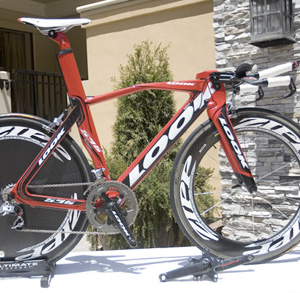
The first question out of my mouth was why? Why a new model? And of course, why that gap in the seat tube and the rear wheel? Is this bike a lateral move? Conventional wisdom says to tuck the wheel and tire as close to the seat post as possible, such as to create a singular surface that the wind sees. LOOK’s own tunnel testing shows that there’s a different possibility.
“The development time line for the 496 and 596 was three years, and we wanted to address aero, weight, stiffness and comfort into a package that would work well for triathlon,” said LOOK marketing manager Ming Tan. “It’s been an emerging market for us. So lot of time was put into creating this frame. There is no afterthought; aerodynamics has become a key aspect of our triathlon frames. And we proudly take a slightly different approach.”
The 596 was designed, prototyped and tested at Magny Cours wind tunnel in Nevers, France, where the LOOK France office reside. At first blush, it looks a lot like the existing 496—it has the same monoblade fork, which was the bike’s signature that after LOOK debuted it and was subsequently adopted by other brands. But there are a heap of differences. The most visible is the bent top tube. Of course, it was the one thing that didn’t have a function to it, serving merely as a visual cue.
Moving from that, the bike sees massive improvements over the previous tri bike, the 496. Weight was my biggest knock on the 496. The stem design, a seeming overbuild of the bottom bracket and general carbon layup made for one of the heaviest tri bikes on the market. The 596 is a departure, carving a massive 400 grams—over a pound—from the 496. Big, big advance. The complete bike on display weighed in at a very respectable 16.5 pounds.
Much of the weight penalty on the 496 came from a very adjustable—but clunky—integrated stem. Replacing that articulating stem on the 596 is a carbon fiber indexed stem, which still has rise and fall option. It’s essentially two rotating carbon arms, which can be moved up or down, and set in either an upper or lower position within a vertical set slot. To take care of reach, four lengths of this proprietary stem (with a 31.8 clamp) will be made available—80mm, 92.5, 105 and 117.5.
Geometrically, the 596 has a 75-degree seat angle. The frame utilizes a carbon fiber R32 e-post, which, when reversed, can get the athlete in upwards of 79 degrees of effective seat angle.
While hidden brake sets are en vogue right now, LOOK opted to stay with what’s safe—and easy to work on. Brakes in their traditional place, with a standard cable run, means that if there’s a problem, you (or your mechanic) can easily remedy it, especially in a high-stress place like the pre-race expo or your hotel room. It makes lives on LOOK’s professional teams that much easier, too.
While we didn’t bring our calipers, the frame itself is narrower through most main tube sets than it’s predecessor. The 596 fork has carbon dropouts, and will be available in four sizes, instead of just three as the previous 496 was. LOOK says the tube set changes resulted in a 10 percent reduction in coefficient of drag. The frame has one set of bottle bosses, so the rest of your fluids will have to go up on the aerobars or behind you.
Why the Gap?
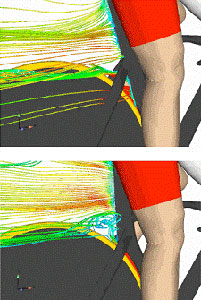
OK, why the gap between the rear wheel and the seat tube? I felt like when they created the 496 that they were just getting into tri and didn’t know better. I mean, everyone knows that a tighter wheel tolerance is right. Right? On the 596, the gap was there again. Knowing how involved in the sport they’ve become, I had to ask. And they had an answer.
Their testing results found this: that while wind moves from the front to the back of a bike, the spinning wheel, particularly with spokes churning it up, pulls some air around the top of the wheel, back through the interior of the stays and toward the seattube. LOOK’s contention is that when the rear wheel I tucked into a tight cowling, it creates a wall. “Without a clear exit path for that air, we found you get a high degree of turbulence,” Tan says. “It goes against conventional wisdom, but that comes from thinking when looking at the bike statically. The story changes with a spinning wheel.”
LOOK says it is undergoing tunnel testing of different wheelsets to determine any variance between different aero section depths. If these guys are on point, perhaps they turn the popular belief that “tight is right” on its ear.
We didn’t get to ride the bike on display, but as to whether there is a noticeable effect, said LOOK International marketing manager Christoph Jouffret: “It’s something you feel,” he said. “When JaJa had that bike for three weeks before Nice, he called and said he regrets he didn’t have such a bike when he was racing. He couldn’t explain, but said it just amazed him, it was something he felt in the bike.
Jouffret added: “ Patrick Vernay went to Roth and won. He said normally he couldn’t stay with the other guys on the bike. He told us he dedicated his victory to the bike. I’ve heard of dedicated a race to your spouse or dying aunt. But a bike? It must be damn good.
Low-tech BMX-tech yields high-zoot carbon crank
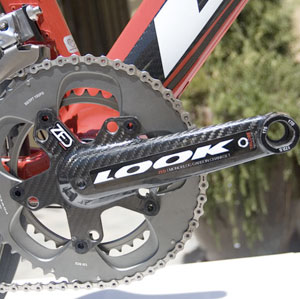
A key advance (and added feature) on the 596 comes with the use of LOOK’s own crankset, the Zed Monobloc, which proprietarily mates with the 596 frame bottom bracket. Most times (well, any time), I’d rather use the stiffest, lightest crank I’ve ever been on, which for me is the Vuma Quad. But LOOK’s own 65mm bottom bracket shell fits this Zed crank, absent a standard threaded BB. But LOOK does provide a sleeve allowing use of standard cranksets if you so choose to shelve the Zed.
For once, I'd go with what's supplied. Because the Zed crank is groundbreaking for its simplicity. For those of us that grew up racing ABA BMX, you’ll recall on your old Mongoose, Haro or Free Agent that the bikes were set up with one-piece Ashtabula cranks; just slide in the non-driveside through the bottom bracket shell, settle in the bearing cup, the cone and washer and you were ready to go.
Now take that premise, make the one-piece crank of hollow carbon fiber, and what you come up with is a clever, simple solution. Granted, the one passed around was absent the bearings, but passed around, it was ungodly light at 320 grams. And since it’s all one unit from spindle to spindle, LOOK says it has a stiffness-to-weight unrivaled by any of their competitors.
Oh, and what about crank lengths? Or whether it’s available in a compact? This one crank does it all.
To address crank length, the Zed introduces Trilobe. Zed crank users must use special LOOK Keo pedals with a special, threadless, triangulated spindle. This titanium spindle has differing depths on each side, putting the eccentric axle at a different point depending on how the axle is installed.
And bolt pattern? The Zed spider has dual bolt placement options; compact 110mm or standard 130mm. The included chainring bolts are specific to the Zed crankset as well.
The question around the launch was when this crank will be made available on other bikes, because for now, the 595 is the only bike it’s made for. “Now you have a universal crankset that will work for everybody,” Tan said. Unless you’re a big guy who runs 180mm crank arms it’s hard to argue.
So frame, fork, post, Zed crankset, stem and Zed Keo pedals? A very, very reasonable $4,999. Reasonable considering that the crankset, LOOK estimates, could (if it was available as an aftermarket product) retails at about $1,000 easily. All that’s needed are wheels, a saddle and a group set and you’re on your way.
LOOK 576
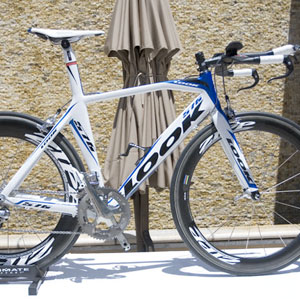
While the 496 will be the bike some may want, the newest bike in LOOK’s line – and evidence that they take the triathlon very seriously, is the new 576, and represents the bike that some may realistically get. If you have a checking account like mine that isn’t flush with a bunch of zeroes, the 576 is the first bike the everyone can get onto a LOOK, the first real price-point offering for a brand that typically resides in the stratosphere. “LOOK is so entrenched in the high-end with our positioning, we wanted to maintain our reputation,” Tan says. “ And we have, as the 576 has the behavior of a high-end bike.”
While it lacks the flash of it’s big brother, the 576 is impressive in it’s own right, wearing wishbone seat stays (it’s been a while since we’ve seen these), deep tubes and an aero seat mast. All told, the 576 frame set ends up at just under 1,100 grams, even with a fork with an alloy steerer. Not bad for a bike with aero tube sets.
While it’s absent the trick Zed crank set in lieu of a standard bottom bracket shell, it still has nice, user-friendly features including a nice rear wheel cowling that rises to the seat stays, replaceable dropouts and two sets of bottle bosses. It also uses the same modulus of carbon as is used on the top-end 596. Frame stiffness is a pervading theme on this one as well, Tan says. “Our test rides have revealed it to be an impressively stiff bike,” Tan says. To wit: the fork’s headset bearings are 1 1/8th on the top, 1 1/4th on the bottom in the front.
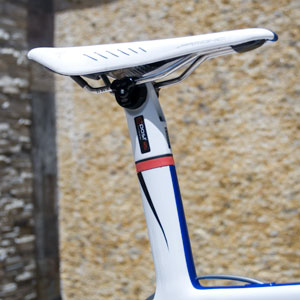
Given that the frame has that cut-to-fit seat mast and the e-Post that sets inside it, that stiffness might be a bad thing in the vertical plane. So LOOK provides customers with three elastomers that slide onto the post between it and the frame. Each rubber post is of a different durometer, or stiffness. Want the stiffest ride? Use the black elastomer. Want the elastomer softer, to absorb some vertical shock load? Use the softer grey elastomer. Again, while we didn’t get to test it, from the looks of it, it may be a good rolling course and climber’s frame.
The reversible e-Post has 5mm of layback and on a bike already with a 78-degree seat angle, that 5mm of play is plenty. The head tube is a bit longer than is found on the 596. I hoped it would be a bit lower to take optimized advantage of the steeper seat angle, but for the target customer, who may not necessarily want to drop their front end that low, LOOK went the safe route.
The 576 Aero will be available in two color options: nude gloss with red accents, and white with blue accents. Pricing for the bike complete with a Shimano Ultegra and 105 mix group set will be $2,999. The frame set alone will be $1,999. While the 596 will be the one in the shop window, the 576 will be the one on the floor in a few sizes, ready to roll out the door to triathletes ranging from the novice first-timer to the mid-pack athlete looking to get onto a choice bike brand, with nice features, at a realistic price. LOOK says it will be available in shops in the fall.
I told Tan that while the 596 will get them in the door, the 576 will get them out under their brand. While there are a lot of competitors in this price range, LOOK clearly just entered the fray with a worthy offering.
And the 496 frame set, the bike that represented LOOK’s first foray into triathlon? It will remain available in the LOOK line, in a red and nude carbon color palate.
And Bell? He continues to wait. Well, he’s not waiting on anything – I was blown from a 70-miler to Ramona a couple weeks ago, and he went spinning by on his 496 Tri. No confirmation on availability yet for the rest of us, but Luke’s hopeful to get it by Kona. Something tells me they’ll get it done.


